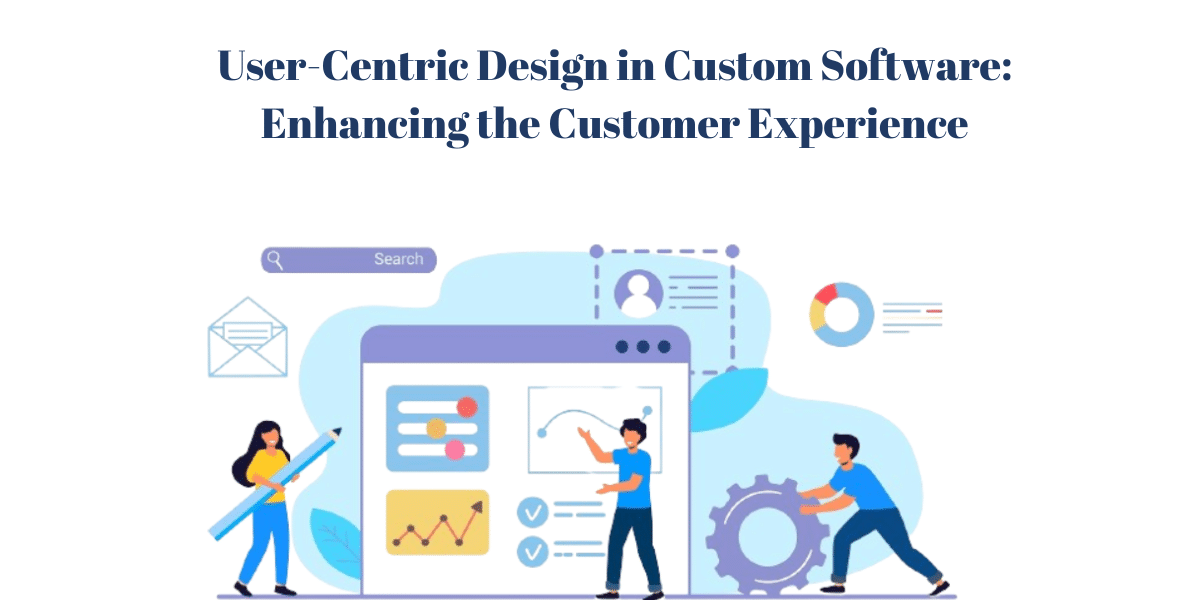In today’s digital landscape, where competition is fierce and customer expectations continue to evolve, businesses must prioritize the user experience to remain relevant and successful. User-centric design, especially in the realm of custom software development, has emerged as a paramount strategy for enhancing customer satisfaction and loyalty.
This approach revolves around placing the needs, preferences, and behaviors of users at the forefront of the design process, ensuring that every aspect of the software aligns with their expectations and facilitates effortless interaction. By understanding the intricacies of user behavior and preferences, businesses can tailor their software solutions to deliver intuitive interfaces, personalized experiences, and seamless functionality.
This introduction sets the stage for exploring the principles, methodologies, and benefits of user-centric design within the context of custom software development, highlighting its pivotal role in driving customer engagement, fostering brand loyalty, and ultimately, achieving business success in a competitive digital landscape.
Importance of Custom Software for Customer Experience
Custom software plays a pivotal role in shaping the customer experience by providing tailored solutions that meet specific needs and preferences. Unlike off-the-shelf software, custom software is uniquely designed to address the unique requirements of a business and its clientele. This tailored approach allows businesses to create intuitive interfaces, streamline processes, and deliver personalized experiences that resonate with their target audience.
By understanding the distinct needs and pain points of their customers, businesses can leverage custom software to optimize user journeys, enhance usability, and ultimately, foster deeper engagement and satisfaction. Additionally, custom software enables businesses to stay agile and responsive to changing customer demands, as updates and enhancements can be implemented swiftly to address evolving needs.
Moreover, custom software empowers businesses to differentiate themselves in a crowded marketplace by offering innovative features and functionalities that set them apart from competitors. Whether it’s through seamless integration with existing systems, advanced analytics capabilities, or enhanced security measures, custom software allows businesses to elevate the customer experience and build lasting relationships with their clientele. In essence, the importance of custom software for customer experience lies in its ability to align with user expectations, empower businesses to deliver exceptional service, and drive sustainable growth in an increasingly digital world.
Key Elements of User-Centric Design
User-centric design encompasses several key elements that are essential for creating intuitive and satisfying experiences for users. Firstly, understanding user needs and behaviors is paramount. This involves conducting thorough research to gain insights into the target audience’s preferences, pain points, and goals. By empathizing with users, designers can tailor solutions that address their specific requirements effectively. Another crucial element is the creation of user personas, which represent fictional characters embodying different user demographics and behaviors.
These personas serve as guiding principles throughout the design process, ensuring that decisions are made with the end user in mind. Additionally, usability is a critical aspect of user-centric design. Interfaces should be intuitive, easy to navigate, and free from unnecessary complexity to enhance user satisfaction and efficiency. Iterative design and testing play a vital role in refining the user experience continuously. By gathering feedback and conducting usability tests, designers can identify areas for improvement and make iterative changes to optimize the design. Accessibility is also key, as software should be inclusive and accessible to users of all abilities. Considering factors such as screen readers, keyboard navigation, and color contrast ensures that everyone can access and use the software effectively.
Finally, personalization adds a layer of customization that enhances user engagement and loyalty. By tailoring experiences based on user preferences, behavior, and history, businesses can create more meaningful interactions that resonate with their audience. Overall, incorporating these key elements of user-centric design results in software that not only meets user needs but also delights and empowers users, ultimately driving success for businesses in the digital landscape.
Defining the User Persona for Custom Software
Defining user personas is a foundational step in the development of custom software, as it allows designers and developers to create solutions that resonate with the specific needs, preferences, and behaviors of target users. User personas are detailed fictional representations of distinct user groups, each characterized by demographics, goals, motivations, challenges, and behaviors. These personas are constructed based on extensive research, including user interviews, surveys, market analysis, and observation.
By synthesizing this information, designers can create personas that accurately reflect the diverse spectrum of users who will interact with the software. Each persona typically includes demographic information such as age, gender, occupation, and location, as well as psychographic details such as preferences, attitudes, and pain points. Additionally, personas often feature scenarios or use cases that illustrate how each user type might interact with the software in various contexts. This level of detail enables designers to empathize with users and make informed decisions throughout the design process, ensuring that the software effectively addresses their needs and goals. Moreover, user personas serve as a valuable communication tool, aligning stakeholders and team members around a shared understanding of the target audience.
By referring back to the personas during development, designers can maintain focus on the user-centered objectives of the project and prioritize features and functionalities accordingly. Ultimately, defining user personas for custom software lays the groundwork for creating intuitive, user-friendly experiences that resonate with the intended audience, driving adoption, satisfaction, and success.
Enhancing Usability Through Intuitive Interfaces
Enhancing usability through intuitive interfaces is a cornerstone of user-centric design, pivotal in ensuring that custom software effectively meets the needs and expectations of its users. Intuitive interfaces are designed with the user’s mental model in mind, aligning closely with their expectations and minimizing the need for extensive learning or instruction. This approach prioritizes simplicity, clarity, and consistency, aiming to create interfaces that are instantly familiar and easy to navigate.
One key strategy for enhancing usability is employing clear and concise labeling and navigation systems, ensuring that users can quickly locate the information or functionality they need. Additionally, visual hierarchy and layout play a crucial role in guiding users’ attention and prioritizing important elements on the screen. Through thoughtful use of color, typography, and spacing, designers can create interfaces that are visually appealing and easy to scan, reducing cognitive load and facilitating efficient interaction. Furthermore, interactive elements such as buttons, links, and menus should behave predictably and responsively, providing feedback to users’ actions and guiding them through the interface seamlessly.
Usability testing is also essential in refining intuitive interfaces, allowing designers to identify usability issues and iteratively improve the user experience. By prioritizing intuitive interfaces in custom software development, businesses can significantly enhance user satisfaction, efficiency, and engagement, ultimately driving adoption and achieving their strategic objectives.
Tailoring Features to Meet User Needs
Tailoring features to meet user needs is a fundamental principle of user-centric design, essential for creating custom software that truly resonates with its intended audience. Understanding and addressing user needs requires a comprehensive approach that begins with thorough research and continues throughout the development process.
This research may involve techniques such as user interviews, surveys, usability testing, and analysis of user behavior data. By gathering insights into the goals, preferences, pain points, and workflows of target users, designers can identify opportunities to tailor features and functionalities that directly address their needs and enhance their overall experience. Prioritizing user needs ensures that the software aligns closely with the expectations and requirements of its intended audience, increasing its relevance and usability.
Additionally, involving users in the design process through methods like co-creation sessions or feedback loops fosters collaboration and ensures that their perspectives are incorporated into the final product. Iterative development allows for ongoing refinement and optimization of features based on user feedback, ensuring that the software remains responsive to evolving needs and preferences.
By continuously refining and tailoring features to meet user needs, businesses can create custom software that not only satisfies users but also drives engagement, loyalty, and ultimately, business success in a competitive marketplace. This user-centric approach not only enhances the usability of the software but also fosters stronger relationships between businesses and their customers, positioning them for long-term growth and sustainability.
The Role of User Feedback in Iterative Design
User feedback plays a crucial role in iterative design, serving as a guiding force throughout the development process to ensure that custom software solutions evolves in alignment with user needs and preferences. Iterative design is a cyclical approach that involves repeated cycles of prototyping, testing, and refining the software based on feedback gathered from users. This feedback serves as invaluable insights into how users interact with the software, identifying areas of confusion, frustration, or inefficiency that need to be addressed.
By soliciting feedback early and often, designers can identify usability issues and make iterative improvements to enhance the overall user experience. This iterative process allows for rapid experimentation and adaptation, enabling designers to test different design solutions and validate their effectiveness in real-world scenarios. Additionally, user feedback fosters a sense of ownership and collaboration, empowering users to contribute to the development process and ensuring that their perspectives are heard and valued.
Incorporating user feedback into iterative design not only results in software that better meets user needs but also builds trust and loyalty among users, as they feel invested in the product’s evolution. Furthermore, user feedback serves as a mechanism for continuous improvement, driving ongoing innovation and iteration even after the initial release of the software. By embracing user feedback as an integral part of the design process, businesses can create custom software that not only satisfies users but also drives engagement, loyalty, and ultimately, business success in a competitive marketplace.
Accessibility Considerations in Custom Software
Accessibility considerations are essential in the development of custom software to ensure inclusivity and usability for all users, regardless of their abilities or disabilities. Prioritizing accessibility means designing software that can be effectively used by individuals with diverse needs, including those with visual, auditory, motor, cognitive, or neurological impairments.
One crucial aspect of accessibility is ensuring compatibility with assistive technologies such as screen readers, voice recognition software, and alternative input devices. Designing software with semantic HTML, proper document structure, and descriptive alt text for images facilitates navigation and comprehension for users who rely on assistive technologies.
Moreover, developers should pay attention to color contrast ratios, font sizes, and keyboard navigation to accommodate users with visual impairments or mobility limitations. Providing alternatives to audio content, such as captions or transcripts, ensures accessibility for users with hearing impairments. Additionally, cognitive accessibility considerations involve simplifying language, minimizing distractions, and providing clear instructions to support users with cognitive disabilities.
Conducting accessibility audits and usability testing with diverse user groups, including individuals with disabilities, helps identify and address accessibility barriers effectively. By integrating accessibility considerations into the design and development process, custom software can reach a broader audience, improve user satisfaction, and demonstrate a commitment to inclusivity and social responsibility. Ultimately, prioritizing accessibility in custom software not only enhances the user experience for individuals with disabilities but also benefits all users by promoting clarity, efficiency, and usability.
Streamlining User Journeys for Seamless Experiences
Streamlining user journeys is a critical aspect of user-centric design, aimed at creating seamless and intuitive experiences for users as they navigate through custom software. User journeys represent the series of steps or interactions that users undertake to accomplish specific tasks or goals within the software.
By understanding the user’s goals, motivations, and pain points, designers can optimize these journeys to minimize friction and maximize efficiency. Streamlining user journeys involves several key strategies. Firstly, designers must identify and prioritize the most common user tasks, ensuring that they are easily accessible and straightforward to complete.
This may involve simplifying complex processes, reducing the number of steps required, or removing unnecessary barriers. Clear and intuitive navigation is essential for guiding users through the software, allowing them to quickly find the information or features they need. Consistent design patterns and familiar interface elements further enhance usability by reducing cognitive load and facilitating rapid task completion.
Personalization also plays a crucial role in streamlining user journeys, as software can adapt to individual user preferences and behaviors, presenting relevant content or options proactively. Continuous iteration and testing are essential for refining and optimizing user journeys over time, as user needs and expectations evolve. By streamlining user journeys, custom software can deliver frictionless experiences that delight users, increase productivity, and drive engagement. Ultimately, prioritizing seamless user experiences not only enhances user satisfaction but also contributes to the overall success and competitiveness of the software in the market.
Personalization: Crafting Unique User Experiences
Personalization in custom software is a powerful strategy for crafting unique user experiences that resonate with individuals on a personal level, driving engagement, loyalty, and satisfaction. By tailoring the software experience to the preferences, behaviors, and characteristics of individual users, businesses can create a sense of connection and relevance that fosters deeper engagement. Personalization begins with the collection and analysis of user data, including demographic information, past interactions, and stated preferences.
This data enables the software to dynamically adapt its content, layout, and functionality to meet the specific needs and interests of each user. Personalization can manifest in various forms, such as recommending relevant content or products, presenting customized dashboards or interfaces, or providing tailored notifications or alerts. Advanced personalization algorithms can even anticipate user needs and preferences, proactively surfacing relevant information or features before users even realize they need them.
Moreover, personalization extends beyond the digital realm, with opportunities to integrate personalized experiences across multiple touchpoints, including mobile apps, websites, email communications, and customer support interactions. However, it’s crucial to balance personalization with user privacy and consent, ensuring that users have control over the data collected and how it’s used. By prioritizing personalization in custom software development, businesses can create differentiated experiences that set them apart from competitors, deepen customer relationships, and drive sustainable growth in an increasingly competitive landscape. Ultimately, personalization empowers businesses to deliver experiences that feel tailored, relevant, and meaningful to each individual user, fostering loyalty and advocacy in the process.
Balancing Functionality with Simplicity
Balancing functionality with simplicity is a delicate yet essential aspect of user-centric design in custom software development, crucial for creating intuitive, efficient, and satisfying user experiences. While it’s tempting to pack software with a myriad of features and capabilities, overwhelming users with complexity can lead to frustration, confusion, and ultimately, disengagement. Therefore, designers must prioritize clarity, ease of use, and efficiency when designing software interfaces and interactions.
This involves carefully considering the needs and capabilities of the target users and focusing on delivering the core functionality that aligns with their goals and priorities. Simplicity doesn’t mean sacrificing functionality; rather, it requires thoughtful prioritization and refinement to ensure that every feature serves a clear purpose and adds value to the user experience. Designing intuitive interfaces with clear navigation, logical organization, and consistent design patterns helps users quickly understand how to interact with the software and accomplish their tasks efficiently.
Additionally, providing contextual guidance, tooltips, and onboarding experiences can further support users in navigating complex functionality without feeling overwhelmed. Regular usability testing and feedback gathering are crucial for identifying areas of unnecessary complexity or confusion and iterating on the design to simplify and streamline the user experience continuously. By striking the right balance between functionality and simplicity, custom software can deliver powerful capabilities while remaining accessible, approachable, and enjoyable to use, ultimately enhancing user satisfaction, productivity, and engagement in the process.
Leveraging Data to Inform Design Decisions
Leveraging data to inform design decisions is a foundational principle of user-centric design, empowering designers and developers to create custom software solutions that are grounded in real-world insights and user behavior. Data serves as a valuable source of information about user preferences, behaviors, and interactions with the software, providing designers with actionable insights to guide decision-making throughout the design process.
Initially, data can be used to inform the creation of user personas, which represent archetypal users and their characteristics, needs, and goals. By analyzing quantitative data such as user demographics, usage patterns, and engagement metrics, designers can develop a deep understanding of the target audience and tailor the software to meet their specific needs and preferences. Moreover, qualitative data from user interviews, surveys, and usability tests offers valuable context and empathy, helping designers uncover underlying motivations, pain points, and opportunities for improvement. Throughout the design process, data-driven design decisions enable designers to prioritize features, functionalities, and design elements based on their impact on user satisfaction, efficiency, and task completion.
A/B testing and iterative prototyping further allow designers to validate design hypotheses and refine the user experience based on user feedback and performance metrics. By continuously leveraging data to inform design decisions, custom software can evolve iteratively to better meet user needs and expectations, driving engagement, loyalty, and ultimately, business success in the digital landscape.
Cross-Platform Compatibility for Maximum Reach
Cross-platform compatibility is a crucial aspect of custom software development, enabling maximum reach and accessibility across a diverse range of devices and operating systems. In today’s digital landscape, users access software applications from various devices such as smartphones, tablets, desktop computers, and wearable devices, each running different platforms like iOS, Android, Windows, and macOS. Ensuring cross-platform compatibility allows businesses to reach a broader audience and provide a consistent user experience regardless of the device or platform used.
Achieving cross-platform compatibility involves several key strategies, including adopting responsive design principles to ensure that software interfaces adapt seamlessly to different screen sizes and orientations. Additionally, leveraging technologies like HTML5, CSS, and JavaScript enables the development of web-based applications that can run on any modern web browser across multiple platforms. For native applications, using cross-platform development frameworks such as React Native, Flutter, or Xamarin allows developers to write code once and deploy it across multiple platforms, reducing development time and costs.
Furthermore, compatibility testing across various devices, browsers, and operating systems is essential to identify and resolve compatibility issues early in the development process. By prioritizing cross-platform compatibility, businesses can extend their software’s reach to a wider audience, increase user engagement, and maintain a competitive edge in the market. Moreover, it enhances user satisfaction by providing a consistent and seamless experience across different devices and platforms, ultimately driving user adoption, retention, and loyalty.
Mobile Optimization for On-the-Go Users
Mobile optimization is a critical component of user-centric design, particularly for custom software solutions aimed at catering to the needs of on-the-go users who rely on smartphones and tablets to access applications while away from traditional desktop environments. As mobile devices continue to proliferate and become primary computing devices for many users, optimizing software for mobile platforms is essential to ensure a seamless and satisfying user experience. Mobile optimization involves several key considerations, starting with responsive design principles that enable software interfaces to adapt dynamically to different screen sizes, resolutions, and orientations.
By prioritizing flexibility and scalability, designers can ensure that users can access and interact with the software comfortably across a wide range of mobile devices. Additionally, optimizing performance is crucial for mobile applications, as users expect fast loading times and smooth interactions even on slower network connections. This involves minimizing file sizes, optimizing code, and leveraging caching and compression techniques to enhance the speed and responsiveness of the software. Furthermore, designing for touch interfaces requires careful consideration of user interaction patterns, such as gestures, swipes, and taps, to ensure intuitive and efficient navigation.
Accessibility is also paramount, with designers paying attention to factors such as font sizes, color contrast, and touch target sizes to accommodate users with diverse needs and preferences. By prioritizing mobile optimization in custom software development, businesses can effectively reach and engage on-the-go users, providing them with the convenience, flexibility, and functionality they need to stay productive and connected in today’s mobile-centric world.
Integrating User-Centric Design into Agile Development
Integrating user-centric design principles into agile software development methodologies is crucial for creating custom software that meets user needs effectively and efficiently. Agile methodologies emphasize iterative development, collaboration, and responsiveness to change, making them well-suited for incorporating user feedback and refining the software iteratively. One key aspect of integrating user-centric design into Agile development is ensuring that user needs and preferences are considered at every stage of the development process.
This begins with the creation of user stories, which capture specific user requirements and goals from the user’s perspective. These user stories serve as the foundation for prioritizing features and functionalities based on their impact on user satisfaction and value. Moreover, involving users directly in the development process through methods like user interviews, usability testing, and feedback sessions fosters collaboration and ensures that their perspectives are incorporated into the design. Designers and developers work closely together in cross-functional teams, iterating on the software based on user feedback and continuously improving the user experience throughout the development lifecycle.
Additionally, Agile methodologies emphasize rapid prototyping and frequent releases, allowing teams to gather feedback early and often, validate design decisions, and adjust quickly in response to changing user needs and market conditions. By integrating user-centric design into Agile development, businesses can create custom software that not only meets user expectations but also drives engagement, satisfaction, and ultimately, business success. This collaborative and iterative approach fosters a culture of continuous improvement, enabling teams to deliver software that delivers maximum value to users and stakeholders.
Prototyping and User Testing for Validation
Prototyping and user testing are indispensable components of the user-centric design process, essential for validating design decisions, gathering feedback, and refining the user experience iteratively. Prototyping involves creating low-fidelity or high-fidelity representations of the software interface and functionality, allowing designers to visualize and test different design concepts and interactions before investing significant resources in development.
These prototypes serve as tangible artifacts for communicating design ideas, soliciting feedback from stakeholders, and iterating on the design based on user input. User testing involves observing users as they interact with the prototypes, capturing their reactions, preferences, and pain points through techniques such as think-aloud protocols, surveys, and usability metrics. By observing users in action, designers can gain valuable insights into how they navigate the software, uncovering usability issues, and validating design decisions.
Iterative cycles of prototyping and user testing enable designers to refine the user experience based on real-world feedback, ensuring that the final product meets user needs and expectations effectively. Moreover, user testing allows designers to validate assumptions, test hypotheses, and identify opportunities for improvement early in the design process, reducing the risk of costly design flaws or usability problems later on. By prioritizing prototyping and user testing for validation, businesses can create custom software that delivers maximum value to users, fosters engagement, and drives business success in an increasingly competitive digital landscape.
Addressing Pain Points Through Design Thinking
Addressing pain points through design thinking is a human-centered approach that focuses on understanding the needs, challenges, and emotions of users to create innovative solutions that truly resonate with them. Design thinking begins with empathizing with users, gaining deep insights into their experiences, frustrations, and aspirations.
By identifying pain points—areas where users encounter difficulties, frustrations, or obstacles—designers can pinpoint opportunities for improvement and innovation. This empathetic understanding forms the foundation for defining the problem space, reframing challenges as opportunities for creative problem-solving.
Through ideation, designers generate a wide range of potential solutions, exploring different possibilities and perspectives to address the identified pain points effectively. Prototyping enables designers to bring these ideas to life quickly and iteratively, creating tangible representations of potential solutions that can be tested and refined based on user feedback. User testing completes the design thinking process, allowing designers to validate assumptions, gather insights, and iterate on the prototypes to ensure that the final solutions effectively address users’ needs and preferences.
By embracing design thinking, businesses can create custom software that not only solves users’ pain points but also delights and empowers them, fostering stronger relationships and driving sustainable growth in an increasingly competitive market. Ultimately, design thinking enables businesses to innovate with empathy, placing the human experience at the center of the design process and creating solutions that make a meaningful difference in users’ lives.
Creating Emotional Engagement with Custom Software
Creating emotional engagement with custom software involves crafting experiences that resonate with users on a deeper, more personal level, eliciting positive emotions and fostering stronger connections between users and the software. One key aspect of creating emotional engagement is designing interfaces and interactions that evoke delight, surprise, or joy. This can be achieved through thoughtful use of visual design, animation, and micro interactions that add personality and charm to the software.
Additionally, leveraging storytelling techniques can help create emotional resonance by framing the user experience within a compelling narrative or context that users can relate to and empathize with. Personalization also plays a crucial role in fostering emotional engagement, as software that adapts to users’ preferences, behaviors, and history can create a sense of ownership and investment. Furthermore, designing for transparency and trustworthiness can help build emotional connections by demonstrating empathy, integrity, and authenticity in the software’s interactions with users. Empowering users through gamification, social features, or community-building elements can also foster emotional engagement by providing opportunities for users to connect with each other, share experiences, and feel a sense of belonging.
Ultimately, creating emotional engagement with custom software development company requires a holistic approach that considers both the functional and emotional aspects of the user experience, aiming to create experiences that not only fulfill users’ needs but also evoke positive emotions, foster loyalty, and inspire advocacy. By prioritizing emotional engagement in custom software design, businesses can create more meaningful and impactful experiences that resonate with users on a deeper level, driving satisfaction, retention, and long-term success.
Measuring Success: Metrics for User-Centric Design
Measuring success in user-centric design requires a comprehensive approach that goes beyond traditional metrics to encompass the holistic impact of the user experience on business objectives, user satisfaction, and engagement. While metrics such as conversion rates, retention rates, and task completion times provide valuable insights into the effectiveness of the software, user-centric design requires a deeper understanding of user behavior, preferences, and perceptions.
One key metric is user satisfaction, measured through methods like surveys, Net Promoter Scores (NPS), or Customer Satisfaction (CSAT) scores, which gauge users’ overall satisfaction with the software experience. Additionally, usability metrics such as task success rates, error rates, and time on task provide insights into the efficiency and effectiveness of the software in meeting user needs. Furthermore, engagement metrics such as session duration, frequency of use, and feature adoption rates indicate the level of user engagement and interaction with the software over time. Qualitative feedback gathered through user interviews, usability testing, and feedback forms offers valuable insights into users’ attitudes, preferences, and pain points, helping to identify areas for improvement and optimization.
Moreover, measuring the impact on business outcomes, such as increased revenue, reduced support costs, or improved customer retention, provides a tangible indication of the software’s value and ROI. By combining quantitative and qualitative metrics, businesses can gain a comprehensive understanding of the success of user-centric design efforts, enabling them to iterate, optimize, and continuously improve the user experience to drive long-term success and competitiveness in the market.
Continuous Improvement through User-Centric Iteration
Continuous improvement through user-centric iteration is a foundational principle in the development of custom software, emphasizing the iterative refinement of the user experience based on ongoing feedback and insights from users. This iterative approach begins with a deep understanding of user needs, preferences, and behaviors, obtained through methods such as user research, interviews, and usability testing.
Armed with these insights, designers and custom software developers create an initial version of the software, known as a Minimum Viable Product (MVP), that focuses on delivering core functionality and features. Once the MVP is released, teams gather feedback from users through various channels, including surveys, feedback forms, and analytics data. This feedback is then analyzed and used to inform iterative improvements to the software, addressing usability issues, adding new features, or refining existing functionality. These iterative cycles of feedback, analysis, and refinement allow the software to evolve continuously, ensuring that it remains aligned with user needs and expectations.
Moreover, embracing user-centric iteration fosters a culture of continuous learning and improvement within the development team, encouraging experimentation, collaboration, and innovation. By prioritizing user feedback and incorporating it into the development process, businesses can create custom software that not only meets user needs effectively but also drives engagement, satisfaction, and long-term success in a rapidly evolving digital landscape. Ultimately, continuous improvement through user-centric iteration enables businesses to stay agile, responsive, and competitive, delivering software that delivers maximum value to users and stakeholders alike.
Collaborative Design: Involving Stakeholders and Users
Collaborative design, which involves actively involving stakeholders and users throughout the design process, is essential for creating custom software that truly meets the needs and expectations of its intended audience. From the outset, it’s crucial to engage stakeholders representing various facets of the business, including executives, product managers, marketers, and customer support representatives. These stakeholders bring diverse perspectives, insights, and requirements to the table, ensuring that the software aligns with the broader strategic goals and objectives of the organization.
Additionally, involving end-users directly in the design process is paramount for creating user-centric solutions that resonate with their needs, preferences, and workflows. Methods such as user interviews, surveys, and participatory design workshops allow designers to gain valuable insights into user behaviors, pain points, and goals, fostering empathy and understanding. Throughout the design process, collaborative design techniques such as co-creation sessions, design sprints, and usability testing workshops facilitate open communication, foster creativity, and encourage cross-functional collaboration.
By involving stakeholders and users in the design process, businesses can ensure that the software addresses real-world needs effectively, mitigates risks, and builds consensus around design decisions. Moreover, collaborative design fosters a sense of ownership and investment among stakeholders and users, increasing buy-in and support for the final product. Ultimately, collaborative design results in custom software that not only meets user needs but also aligns with organizational goals, driving adoption, satisfaction, and success in the marketplace.
Ethical Considerations in User-Centric Design
Ethical considerations in user-centric design are paramount, as custom software designers have a responsibility to prioritize the well-being and rights of users while creating custom software solutions. One key ethical consideration is privacy protection, ensuring that user data is collected, stored, and used responsibly, with clear consent and transparency regarding how it will be used.
Designers must also consider inclusivity and accessibility, designing software that is accessible to users of all abilities and backgrounds, and avoiding bias or discrimination in the design process. Moreover, designers should prioritize user autonomy and agency, empowering users to make informed choices and control their interactions with the software. This involves providing clear and understandable options for consent, data sharing, and privacy settings, as well as avoiding manipulative or coercive design practices.
Transparency is another critical ethical consideration, as designers should be transparent about the limitations, risks, and potential consequences of using the software, ensuring that users are fully informed before engaging with it. Additionally, designers should consider the broader societal impacts of their designs, including environmental sustainability, social justice, and economic equity. By incorporating ethical considerations into user-centric design, designers can create software that not only meets user needs effectively but also upholds ethical principles, fosters trust, and promotes the well-being of users and society as a whole. Ultimately, prioritizing ethics in user-centric design is essential for creating software that aligns with values of integrity, responsibility, and respect for human rights, contributing to a more ethical and sustainable digital future.
Designing for Trust and Security
Designing for trust and security is paramount in user-centric design, especially in the development of custom software where user confidence is essential for adoption and continued use. Trust is established when users feel confident that their personal information is handled responsibly and securely. Therefore, designers must prioritize the implementation of robust security measures to safeguard user data from unauthorized access, breaches, and misuse.
This involves adopting encryption protocols, secure authentication mechanisms, and regular security audits to identify and address vulnerabilities. Additionally, transparency is crucial in building trust, as users should be informed about how their data is collected, stored, and used within the software. Providing clear privacy policies, consent mechanisms, and data management controls empowers users to make informed decisions about their privacy and security.
Moreover, fostering a culture of trust involves demonstrating reliability and accountability in the handling of user data, promptly addressing security incidents and communicating transparently with users about any risks or impacts. Beyond technical measures, designing for trust also encompasses creating intuitive and user-friendly interfaces that inspire confidence and reassurance. Visual cues such as padlock icons, security badges, and HTTPS indicators can signal to users that their interactions with the software are secure.
By prioritizing trust and security in the design process, designers can create custom software that not only meets user needs effectively but also fosters trust, confidence, and loyalty among users, driving adoption and long-term success in the marketplace. Ultimately, designing for trust and security is essential for upholding user trust, protecting sensitive information, and maintaining the integrity of the software and the organization behind it.
Educating Users for Optimal Utilization
Educating users for optimal utilization is a crucial aspect of user-centric design, ensuring that users can effectively navigate, understand, and leverage the features and functionalities of custom software to their fullest extent. The design process should prioritize creating intuitive interfaces and clear user instructions to minimize the need for extensive training or support.
However, recognizing that some users may still require guidance, providing comprehensive educational resources such as user guides, tutorials, and interactive help features can empower users to learn at their own pace and troubleshoot issues independently. Moreover, incorporating contextual guidance directly within the software interface, such as tooltips, walkthroughs, and onboarding sequences, can assist users in understanding complex workflows or features in real-time. Additionally, fostering a culture of learning and knowledge sharing through community forums, user groups, and peer-to-peer support networks can provide users with ongoing opportunities to expand their skills and expertise.
Regular communication and updates about new features, best practices, and tips for optimization further reinforce users’ understanding and confidence in utilizing the software effectively. By prioritizing user education in the design process, businesses can enhance user satisfaction, reduce support costs, and drive long-term engagement and loyalty. Ultimately, educating users for optimal utilization not only maximizes the value of the software for individual users but also contributes to the overall success and competitiveness of the organization in the market.
Future Trends in User-Centric Design for Custom Software
Future trends in user-centric design for custom software are likely to be shaped by advancements in technology, evolving user expectations, and emerging societal trends. One prominent trend is the increasing integration of artificial intelligence (AI) and machine learning (ML) technologies into custom software solutions, enabling personalized and predictive user experiences.
AI-powered chatbots and virtual assistants will become more sophisticated, offering users intuitive and conversational interfaces for interacting with software and accessing information or services. Additionally, the Internet of Things (IoT) will continue to influence user-centric design, as software interfaces expand to encompass interconnected devices and sensors, offering users seamless control and monitoring capabilities across various touchpoints. Furthermore, the rise of immersive technologies such as virtual reality (VR) and augmented reality (AR) will present new opportunities for creating immersive and engaging user experiences, particularly in industries such as gaming, education, and retail.
Designing for accessibility and inclusivity will also remain a priority, with a focus on creating software that accommodates users of all abilities and backgrounds. Moreover, ethical considerations will play an increasingly significant role in user-centric design, as designers grapple with issues such as privacy, data security, algorithmic bias, and the societal impacts of technology. Ultimately, the future of user-centric design for custom software will be characterized by a holistic approach that integrates advanced technologies with human-centered principles, fostering experiences that are not only intuitive, efficient, and engaging but also ethical, inclusive, and empowering for users.
The Key Takeaway
In conclusion, user-centric design lies at the heart of creating successful custom software solutions that meet the evolving needs and expectations of users. Throughout this discussion, we’ve explored various principles and strategies, from leveraging data-driven insights to prioritizing trust and security, educating users, and embracing emerging trends.
By placing users at the forefront of the design process, businesses can create software that not only addresses functional requirements but also fosters meaningful connections, enhances satisfaction, and drives long-term engagement and loyalty. Looking ahead, future trends in user-centric design, such as AI integration, IoT connectivity, immersive technologies, and ethical considerations, will continue to shape the landscape, offering exciting opportunities to create even more personalized, accessible, and impactful user experiences.
Ultimately, by embracing user-centric design principles and staying attuned to the evolving needs of users, businesses can position themselves for success in an increasingly competitive and user-driven digital ecosystem.











